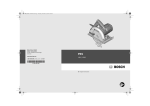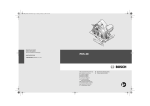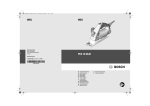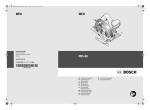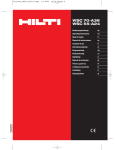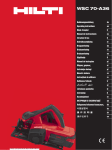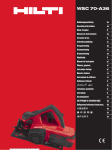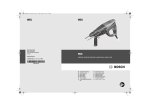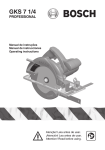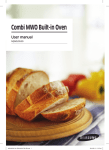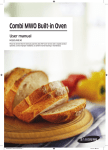Download Bosch PKS 40 Instruction manual
Transcript
OBJ_DOKU-2683-004.fm Page 1 Friday, April 12, 2013 9:40 AM WEU Robert Bosch GmbH Power Tools Division 70745 Leinfelden-Echterdingen Germany WEU PKS 40 www.bosch-pt.com 1 609 92A 06G (2013.04) I / 100 WEU de en fr es pt it nl Originalbetriebsanleitung Original instructions Notice originale Manual original Manual original Istruzioni originali Oorspronkelijke gebruiksaanwijzing da Original brugsanvisning sv Bruksanvisning i original no Original driftsinstruks fi Alkuperäiset ohjeet el tr Πρωτότυπο οδηγιών χρήσης Orijinal işletme talimatı OBJ_BUCH-179-004.book Page 3 Friday, April 12, 2013 9:22 AM |3 1 2 3 17 16 15 14 4 5 18 4 13 6 12 11 7 10 8 9 PKS 40 A 19 20 23 3 Bosch Power Tools 22 9 8 12 21 24 1 609 92A 06G | (12.4.13) OBJ_BUCH-179-004.book Page 4 Friday, April 12, 2013 9:22 AM 4| C B 25 15 12 40 14 2,5 - 5 mm 2,5 - 5 mm E D 26 10 F 0 1 609 92A 06G | (12.4.13) 1-45 Bosch Power Tools OBJ_BUCH-179-004.book Page 5 Friday, April 12, 2013 9:22 AM |5 G 26 27 28 29 30 Bosch Power Tools 1 609 92A 06G | (12.4.13) OBJ_BUCH-179-004.book Page 13 Friday, April 12, 2013 9:22 AM English | 13 Deutschland Robert Bosch GmbH Servicezentrum Elektrowerkzeuge Zur Luhne 2 37589 Kalefeld – Willershausen Unter www.bosch-pt.com können Sie online Ersatzteile bestellen oder Reparaturen anmelden. Kundendienst: Tel.: (0711) 40040480 Fax: (0711) 40040481 E-Mail: [email protected] Anwendungsberatung: Tel.: (0711) 40040480 Fax: (0711) 40040482 E-Mail: [email protected] Österreich Tel.: (01) 797222010 Fax: (01) 797222011 E-Mail: [email protected] Schweiz Tel.: (044) 8471511 Fax: (044) 8471551 E-Mail: [email protected] Luxemburg Tel.: +32 2 588 0589 Fax: +32 2 588 0595 E-Mail: [email protected] Entsorgung Elektrowerkzeuge, Zubehör und Verpackungen sollen einer umweltgerechten Wiederverwertung zugeführt werden. Nur für EU-Länder: Gemäß der Europäischen Richtlinie 2012/19/EU über Elektro- und ElektronikAltgeräte und ihrer Umsetzung in nationales Recht müssen nicht mehr gebrauchsfähige Elektrowerkzeuge getrennt gesammelt und einer umweltgerechten Wiederverwertung zugeführt werden. Änderungen vorbehalten. English Safety Notes General Power Tool Safety Warnings Read all safety warnings and all instructions. Failure to follow the warnings and instructions may result in electric shock, fire and/or serious injury. Save all warnings and instructions for future reference. The term “power tool” in the warnings refers to your mainsoperated (corded) power tool or battery-operated (cordless) power tool. WARNING Bosch Power Tools Work area safety Keep work area clean and well lit. Cluttered or dark areas invite accidents. Do not operate power tools in explosive atmospheres, such as in the presence of flammable liquids, gases or dust. Power tools create sparks which may ignite the dust or fumes. Keep children and bystanders away while operating a power tool. Distractions can cause you to lose control. Electrical safety Power tool plugs must match the outlet. Never modify the plug in any way. Do not use any adapter plugs with earthed (grounded) power tools. Unmodified plugs and matching outlets will reduce risk of electric shock. Avoid body contact with earthed or grounded surfaces, such as pipes, radiators, ranges and refrigerators. There is an increased risk of electric shock if your body is earthed or grounded. Do not expose power tools to rain or wet conditions. Water entering a power tool will increase the risk of electric shock. Do not abuse the cord. Never use the cord for carrying, pulling or unplugging the power tool. Keep cord away from heat, oil, sharp edges and moving parts. Damaged or entangled cords increase the risk of electric shock. When operating a power tool outdoors, use an extension cord suitable for outdoor use. Use of a cord suitable for outdoor use reduces the risk of electric shock. If operating a power tool in a damp location is unavoidable, use a residual current device (RCD) protected supply. Use of an RCD reduces the risk of electric shock. Personal safety Stay alert, watch what you are doing and use common sense when operating a power tool. Do not use a power tool while you are tired or under the influence of drugs, alcohol or medication. A moment of inattention while operating power tools may result in serious personal injury. Use personal protective equipment. Always wear eye protection. Protective equipment such as dust mask, non-skid safety shoes, hard hat, or hearing protection used for appropriate conditions will reduce personal injuries. Prevent unintentional starting. Ensure the switch is in the off-position before connecting to power source and/or battery pack, picking up or carrying the tool. Carrying power tools with your finger on the switch or energising power tools that have the switch on invites accidents. Remove any adjusting key or wrench before turning the power tool on. A wrench or a key left attached to a rotating part of the power tool may result in personal injury. Do not overreach. Keep proper footing and balance at all times. This enables better control of the power tool in unexpected situations. 1 609 92A 06G | (12.4.13) OBJ_BUCH-179-004.book Page 14 Friday, April 12, 2013 9:22 AM 14 | English Dress properly. Do not wear loose clothing or jewellery. Keep your hair, clothing and gloves away from moving parts. Loose clothes, jewellery or long hair can be caught in moving parts. If devices are provided for the connection of dust extraction and collection facilities, ensure these are connected and properly used. Use of dust collection can reduce dust-related hazards. Power tool use and care Do not force the power tool. Use the correct power tool for your application. The correct power tool will do the job better and safer at the rate for which it was designed. Do not use the power tool if the switch does not turn it on and off. Any power tool that cannot be controlled with the switch is dangerous and must be repaired. Disconnect the plug from the power source and/or the battery pack from the power tool before making any adjustments, changing accessories, or storing power tools. Such preventive safety measures reduce the risk of starting the power tool accidentally. Store idle power tools out of the reach of children and do not allow persons unfamiliar with the power tool or these instructions to operate the power tool. Power tools are dangerous in the hands of untrained users. Maintain power tools. Check for misalignment or binding of moving parts, breakage of parts and any other condition that may affect the power tool’s operation. If damaged, have the power tool repaired before use. Many accidents are caused by poorly maintained power tools. Keep cutting tools sharp and clean. Properly maintained cutting tools with sharp cutting edges are less likely to bind and are easier to control. Use the power tool, accessories and tool bits etc. in accordance with these instructions, taking into account the working conditions and the work to be performed. Use of the power tool for operations different from those intended could result in a hazardous situation. Service Have your power tool serviced by a qualified repair person using only identical replacement parts. This will ensure that the safety of the power tool is maintained. Safety Warnings for Circular Saws DANGER: Keep hands away from cutting area and the blade. Keep your second hand on auxiliary handle, or motor housing. If both hands are holding the saw, they cannot be cut by the blade. Do not reach underneath the workpiece. The guard cannot protect you from the blade below the workpiece. Adjust the cutting depth to the thickness of the workpiece. Less than a full tooth of the blade teeth should be visible below the workpiece. Never hold piece being cut in your hands or across your leg. Secure the workpiece to a stable platform. It is im- 1 609 92A 06G | (12.4.13) portant to support the work properly to minimize body exposure, blade binding, or loss of control. Hold the power tool by the insulated gripping surfaces only, when performing an operation where the cutting tool may contact hidden wiring or its own cord. Contact with a “live” wire will also make exposed metal parts of the power tool “live” and could give the operator an electric shock. When ripping always use a rip fence or straight edge guide. This improves the accuracy of cut and reduces the chance of blade binding. Always use blades with correct size and shape (diamond versus round) of arbour holes. Blades that do not match the mounting hardware of the saw will run eccentrically, causing loss of control. Never use damaged or incorrect blade washers or bolt. The blade washers and bolt were specially designed for your saw, for optimum performance and safety of operation. Kickback causes and related warnings – Kickback is a sudden reaction to a pinched, bound or misaligned saw blade, causing an uncontrolled saw to lift up and out of the workpiece toward the operator; – When the blade is pinched or bound tightly by the kerf closing down, the blade stalls and the motor reaction drives the unit rapidly back toward the operator; – If the blade becomes twisted or misaligned in the cut, the teeth at the back edge of the blade can dig into the top surface of the wood causing the blade to climb out of the kerf and jump back toward the operator. Kickback is the result of saw misuse and/or incorrect operating procedures or conditions and can be avoided by taking proper precautions as given below. Maintain a firm grip with both hands on the saw and position your arms to resist kickback forces. Position your body to either side of the blade, but not in line with the blade. Kickback could cause the saw to jump backwards, but kickback forces can be controlled by the operator, if proper precautions are taken. When blade is binding, or when interrupting a cut for any reason, release the trigger and hold the saw motionless in the material until the blade comes to a complete stop. Never attempt to remove the saw from the work or pull the saw backward while the blade is in motion or kickback may occur. Investigate and take corrective actions to eliminate the cause of blade binding. When restarting a saw in the workpiece, centre the saw blade in the kerf and check that saw teeth are not engaged into the material. If saw blade is binding, it may walk up or kickback from the workpiece as the saw is restarted. Support large panels to minimise the risk of blade pinching and kickback. Large panels tend to sag under their own weight. Supports must be placed under the panel on both sides, near the line of cut and near the edge of the panel. Bosch Power Tools OBJ_BUCH-179-004.book Page 15 Friday, April 12, 2013 9:22 AM English | 15 Do not use dull or damaged blades. Unsharpened or improperly set blades produce narrow kerf causing excessive friction, blade binding and kickback. Blade depth and bevel adjusting locking levers must be tight and secure before making cut. If blade adjustment shifts while cutting, it may cause binding and kickback. Use extra caution when sawing into existing walls or other blind areas. The protruding blade may cut objects that can cause kickback. Check lower guard for proper closing before each use. Do not operate the saw if lower guard does not move freely and close instantly. Never clamp or tie the lower guard into the open position. If saw is accidentally dropped, lower guard may be bent. Raise the lower guard with the retracting handle and make sure it moves freely and does not touch the blade or any other part, in all angles and depths of cut. Check the operation of the lower guard spring. If the guard and the spring are not operating properly, they must be serviced before use. Lower guard may operate sluggishly due to damaged parts, gummy deposits, or a build-up of debris. Lower guard may be retracted manually only for special cuts such as “plunge cuts” and “compound cuts”. Raise lower guard by retracting handle and as soon as blade enters the material, the lower guard must be released. For all other sawing, the lower guard should operate automatically. Always observe that the lower guard is covering the blade before placing saw down on bench or floor. An unprotected, coasting blade will cause the saw to walk backwards, cutting whatever is in its path. Be aware of the time it takes for the blade to stop after switch is released. Use the appropriate saw blade for the riving knife. For the riving knife to function, the body of the blade must be thinner than the riving knife and the cutting width of the balde must be wider than the thickness of the riving knife. Adjust the riving knife as described in this instruction manual. Incorrect spacing, positioning and alignment can make the riving knife ineffective in preventing kickback. Always use the riving knife except when plunge cutting. Riving knife must be replaced after plunge cutting. Riving knife causes interference during plunge cutting and can create kickback. For the riving knife to work, it must be engaged in the workpiece. The riving knife is ineffective in preventing kickback during short cuts. Do not operate the saw if riving knife is bent. Even a light interference can slow the closing rate of a guard. Do not reach into the saw dust ejector with your hands. They could be injured by rotating parts. Do not work overhead with the saw. In this manner you do not have sufficient control over the power tool. Use suitable detectors to determine if utility lines are hidden in the work area or call the local utility company for assistance. Contact with electric lines can lead to fire Bosch Power Tools and electric shock. Damaging a gas line can lead to explosion. Penetrating a water line causes property damage or may cause an electric shock. Do not operate the power tool stationary. It is not designed for operation with a saw table. Do not use high speed steel (HSS) saw blades. Such saw blades can easily break. Do not saw ferrous metals. Red hot chips can ignite the dust extraction. When working with the machine, always hold it firmly with both hands and provide for a secure stance. The power tool is guided more secure with both hands. Secure the workpiece. A workpiece clamped with clamping devices or in a vice is held more secure than by hand. Always wait until the machine has come to a complete stop before placing it down. The tool insert can jam and lead to loss of control over the power tool. Never use the machine with a damaged cable. Do not touch the damaged cable and pull the mains plug when the cable is damaged while working. Damaged cables increase the risk of an electric shock. Products sold in GB only: Your product is fitted with an BS 1363/A approved electric plug with internal fuse (ASTA approved to BS 1362). If the plug is not suitable for your socket outlets, it should be cut off and an appropriate plug fitted in its place by an authorised customer service agent. The replacement plug should have the same fuse rating as the original plug. The severed plug must be disposed of to avoid a possible shock hazard and should never be inserted into a mains socket elsewhere. Products sold in AUS and NZ only: Use a residual current device (RCD) with a rated residual current of 30 mA or less. Product Description and Specifications Read all safety warnings and all instructions. Failure to follow the warnings and instructions may result in electric shock, fire and/or serious injury. Intended Use The machine is intended for lengthways and crossways cutting of wood with straight cutting lines as well as mitre cuts in wood while resting firmly on the workpiece. With suitable saw blades, thin-walled non-ferrous metals, e. g., profiles, can also be sawed. Working ferrous metals is not permitted. Product Features The numbering of the product features refers to the illustration of the machine on the graphics page. 1 On/Off switch 2 Lock-off button for On/Off switch 1 609 92A 06G | (12.4.13) OBJ_BUCH-179-004.book Page 16 Friday, April 12, 2013 9:22 AM 16 | English 3 4 5 6 7 8 9 10 11 12 13 14 15 16 17 18 19 20 21 22 23 24 25 26 27 28 29 30 Allen key Auxiliary handle (insulated gripping surface) Scale for mitre angle Wing bolt for bevel-angle preselection Wing bolt for parallel guide Cutting mark, 45° Cutting mark, 0° Parallel guide Retracting blade guard Riving knife Base plate Wing bolt for cutting depth preselection Cutting-depth scale Blade guard Sawdust ejector Handle (insulated gripping surface) Saw spindle* Clamping flange Saw blade* Mounting flange Clamping bolt with washer Open-end spanner, size 22 mm Screw for attachment of riving knife Set of screw clamps* Guide-rail adapter* Guide rail* Connection piece* Vacuum hose* Circular Saw Mounting bore Weight according to EPTA-Procedure 01/2003 Protection class kg PKS 40 16 2.4 / II The values given are valid for a nominal voltage [U] of 230 V. For different voltages and models for specific countries, these values can vary. Noise/Vibration Information *Accessories shown or described are not part of the standard delivery scope of the product. A complete overview of accessories can be found in our accessories program. Technical Data Circular Saw Article number Rated power input Output power No-load speed Rotational speed under load, max. Riving knife thickness, max. Cutting depth, max. – for 0° bevel angle – for 45° bevel angle Base plate dimensions Saw blade diameter, max. Saw blade diameter, min. Blade thickness, max. Tooth thickness/setting, max. Tooth thickness/setting, min. mm W W min-1 PKS 40 3 603 C28 0.. 600 350 4500 min-1 mm 2450 1,5 mm mm mm mm mm mm mm mm 40 26 120 x 260 130 122 1.4 2.7 1.7 Measured sound values determined according to EN 60745. Typically the A-weighted noise levels of the product are: Sound pressure level 97 dB(A); Sound power level 108 dB(A). Uncertainty K =3 dB. Wear hearing protection! Vibration total values ah (triax vector sum) and uncertainty K determined according to EN 60745: ah <2.5 m/s2, K=1.5 m/s2. The vibration emission level given in this information sheet has been measured in accordance with a standardised test given in EN 60745 and may be used to compare one tool with another. It may be used for a preliminary assessment of exposure. The declared vibration emission level represents the main applications of the tool. However if the tool is used for different applications, with different accessories or poorly maintained, the vibration emission may differ. This may significantly increase the exposure level over the total working period. An estimation of the level of exposure to vibration should also take into account the times when the tool is switched off or when it is running but not actually doing the job. This may significantly reduce the exposure level over the total working period. Identify additional safety measures to protect the operator from the effects of vibration such as: maintain the tool and the accessories, keep hands warm, organise work patterns. Declaration of Conformity We declare under our sole responsibility that the product described under “Technical Data” is in conformity with the following standards or standardization documents: EN 60745 according to the provisions of the directives 2011/65/EU, 2004/108/EC, 2006/42/EC. Technical file (2006/42/EC) at: Robert Bosch GmbH, Postfach 10 01 56, D-70745 Leinfelden-Echterdingen Dr. Egbert Schneider Helmut Heinzelmann Senior Vice President Head of Product Certification Engineering PT/ETM9 Robert Bosch GmbH, Power Tools Division D-70745 Leinfelden-Echterdingen Leinfelden, 10.01.2008 The values given are valid for a nominal voltage [U] of 230 V. For different voltages and models for specific countries, these values can vary. 1 609 92A 06G | (12.4.13) Bosch Power Tools OBJ_BUCH-179-004.book Page 17 Friday, April 12, 2013 9:22 AM English | 17 Assembly Mounting/Replacing the Saw Blade Before any work on the machine itself, pull the mains plug. When mounting the saw blade, wear protective gloves. Danger of injury when touching the saw blade. Only use saw blades that correspond with the characteristic data given in the operating instructions. Do not under any circumstances use grinding discs as the cutting tool. Selecting a Saw Blade An overview of recommended saw blades can be found at the end of this manual. Removal of the Saw Blade (see figure A) – Tilt back the retracting blade guard 11 and hold firmly. – Lock the clamping flange 20 using an open-end spanner 24 (size 22 mm) or position the saw blade 21 onto a piece of wood. – With the Allen key 3, unscrew the clamping bolt 23 turning in rotation direction . – Remove the clamping flange 20 and the saw blade 21 from the saw spindle 19. Mounting the Saw Blade (see figure A) – Clean the saw blade 21 and all clamping parts to be assembled. – Tilt back the retracting blade guard 11 and hold firmly. – Place the saw blade 21 on to the mounting flange 22. The cutting direction of the teeth (direction or arrow on saw blade) and the direction-of-rotation arrow on the blade guard 16 must correspond. – Mount the clamping flange 20 and screw in the clamping bolt 23 turning in rotation direction . Observe correct mounting position of mounting flange 22 and clamping flange 20. – Lock the clamping flange 20 using an open-end spanner 24 (size 22 mm) or position the saw blade 21 onto a piece of wood. – With the Allen key 3, tighten the clamping bolt 23 turning in rotation direction . The tightening torque is between 6–9 Nm, which corresponds to hand tight plus ¼ turn. Adjusting the Riving Knife (see figure B) Before any work on the machine itself, pull the mains plug. Always work with the riving knife, except when carrying out plunge cuts. The riving knife prevents jamming of the saw blade while sawing. Adjustment is carried out at maximum cutting depth, see Section “Adjusting the Cutting Depth”. Loosen screw 25, adjust the riving knife 12 to the measure shown in the figure and tighten screw 25 with a tightening torque between 3.5–5 Nm. Bosch Power Tools Dust/Chip Extraction Before any work on the machine itself, pull the mains plug. Dusts from materials such as lead-containing coatings, some wood types, minerals and metal can be harmful to one’s health. Touching or breathing-in the dusts can cause allergic reactions and/or lead to respiratory infections of the user or bystanders. Certain dusts, such as oak or beech dust, are considered as carcinogenic, especially in connection with wood-treatment additives (chromate, wood preservative). Materials containing asbestos may only be worked by specialists. – As far as possible, use a dust extraction system suitable for the material. – Provide for good ventilation of the working place. – It is recommended to wear a P2 filter-class respirator. Observe the relevant regulations in your country for the materials to be worked. External Dust Extraction Mount the vacuum hose 30 (accessory) on to the saw dust ejector 17. Connect the vacuum hose 30 to a vacuum cleaner (accessory). An overview for connecting to various vacuum cleaners can be found at the end of this manual. The machine can be plugged directly into the receptacle of a Bosch all-purpose vacuum cleaner with remote starting control. The vacuum cleaner starts automatically when the machine is switched on. The vacuum cleaner must be suitable for the material being worked. When vacuuming dry dust that is especially detrimental to health or carcinogenic, use a special vacuum cleaner. Integrated Dust Extraction with Dust Bag For smaller jobs, a dust bag (accessory) can be mounted. Insert the dust bag sleeve firmly into the saw dust ejector 17. Empty the dust bag at regular intervals to maintain optimum dust collection. Operation Operating Modes Before any work on the machine itself, pull the mains plug. Adjusting the Cutting Depth (see figure C) Adjust the cutting depth to the thickness of the workpiece. Less than a full tooth of the blade teeth should be visible below the workpiece. Loosen wing bolt 14. For a smaller cutting depth, pull the saw away from the base plate 13; for a larger cutting depth, push the saw toward the base plate 13. Adjust the desired cutting depth at the cutting-depth scale. Tighten wing bolt 14 again. Adjusting the Cutting Angle Loosen wing bolt 6. Tilt the saw sidewards. Adjust the desired setting at the scale 5. Tighten wing bolt 6 again. Note: For bevel cuts, the cutting depth is smaller than the setting indicated on the cutting-depth scale 15. 1 609 92A 06G | (12.4.13) OBJ_BUCH-179-004.book Page 18 Friday, April 12, 2013 9:22 AM 18 | English Cutting Marks or 8; see Section “Cutting Marks”. Tighten wing bolt 7 again. 45 0 45 0 The 0° cutting mark (9) indicates the position of the saw blade for right-angled cuts. The 45° cutting mark (8) indicates the position of the saw blade for 45° cuts. For precise cuts, position the circular saw against the workpiece as shown in the figure. It is best to carry out a trial cut. Starting Operation Observe correct mains voltage! The voltage of the power source must agree with the voltage specified on the nameplate of the machine. Power tools marked with 230 V can also be operated with 220 V. Switching On and Off To save energy, only switch the power tool on when using it. To start the machine, first push the lock-off button for the On/Off switch 2 and then press the On/Off switch 1 and keep it pressed. To switch off the machine, release the On/Off switch 1. Note: For safety reasons, the On/Off switch 1 cannot be locked; it must remain pressed during the entire operation. Sawing with Auxiliary Guide (see figure E) For sawing large workpieces or straight edges, a board or strip can clamped to the workpiece as an auxiliary guide; the base plate of the circular saw can be guided alongside the auxiliary guide. Sawing with Guide Rail (see figure G) The guide rail 28 is used to carry out straight cuts. The adhesive coating prevents the guide rail from slipping and protects the surface of the workpiece. The coating of the guide rail allows the circular saw to glide easily. The rubber lip on the guide rail acts as a splinter guard; it prevents fraying of the surface while sawing wooden materials. For this, the teeth of the saw blade must face directly against the rubber lip. The guide rail 28 must not extend beyond the face side of the workpiece where the cut is to be started. The guide-rail adapter 27 is required for working with the guide rail 28. The guide-rail adapter 27 is mounted in the same manner as the parallel guide 10. The following work steps are required for exact cuts using the guide rail 28: – Place the guide rail 28 on to the workpiece projecting lightly over the side. Pay attention that the side with the rubber lip faces to the workpiece. Working Advice Protect saw blades against impact and shock. Guide the machine evenly and with light feed in the cutting direction. Excessive feed significantly reduces the service life of the saw blade and can cause damage to the power tool. Sawing performance and cutting quality depend essentially on the condition and the tooth form of the saw blade. Therefore, use only sharp saw blades that are suited for the material to be worked. Sawing Wood The correct selection of the saw blade depends on the type and quality of the wood and whether lengthway or crossway cuts are required. When cutting spruce lengthways, long spiral chips are formed. Beech and oak dusts are especially detrimental to health. Therefore, work only with dust extraction. Sawing with Parallel Guide (see figure D) The parallel guide 10 enables exact cuts along a workpiece edge and cutting strips of the same dimension. Loosen wing bolt 7 and slide the scale of the parallel guide 10 through the guide in the base plate 13. Adjust the desired cutting width as the scale setting at the respective cutting mark 9 1 609 92A 06G | (12.4.13) – Set the circular saw with the premounted guide-rail adapter 27 on to the guide rail 28. – Adjust the desired cutting depth and the bevel angle. Observe the marks on the guide-rail adapter 27 for preadjustment of the various bevel angles; see figure F. – Align the circular saw with guide-rail adapter in such a manner that the teeth of the saw blade 21 face against the rubber lip. The position of the saw blade 21 depends on the selected cutting angle. Do not saw into the guide rail. 0° 1-45° Bosch Power Tools OBJ_BUCH-179-004.book Page 19 Friday, April 12, 2013 9:22 AM English | 19 – Tighten wing bolt 7 to lock the position of the guide-rail adapter. – Remove the circular saw with the premounted guide-rail adapter 27 from the guide rail 28. – Align the guide rail 28 on the workpiece in such a manner that the rubber lip lies exactly alongside the cutting edge. – Fasten the guide rail 28 with suitable clamping devices, e. g., screw clamps, on the workpiece. Set the circular saw with the premounted guide-rail adapter 27 on to the guide rail. – Switch the machine on and guide it in the cutting direction applying moderate and steady feed. Two guide rails can be connected to one with use of the connection piece 29. Clamping is carried out with the four screws located in the connection piece. Maintenance and Service Maintenance and Cleaning Before any work on the machine itself, pull the mains plug. For safe and proper working, always keep the machine and ventilation slots clean. The retracting blade guard must always be able to move freely and retract automatically. Therefore, always keep the area around the retracting blade guard clean. Remove dust and chips by blowing out with compressed air or with a brush. Saw blades that are not coated can be protected against corrosion with a thin coat of acid-free oil. Before use, the oil must be removed again, otherwise the wood will become soiled. Resin and glue residue on the saw blade produces poor cuts. Therefore, clean the saw blade immediately after use. If the machine should fail despite the care taken in manufacturing and testing procedures, repair should be carried out by an after-sales service centre for Bosch power tools. If the replacement of the supply cord is necessary, this has to be done by Bosch or an authorized Bosch service agent in order to avoid a safety hazard. In all correspondence and spare parts order, please always include the 10-digit article number given on the type plate of the machine. Great Britain Robert Bosch Ltd. (B.S.C.) P.O. Box 98 Broadwater Park North Orbital Road Denham Uxbridge UB 9 5HJ Tel. Service: (0844) 7360109 Fax: (0844) 7360146 E-Mail: [email protected] Ireland Origo Ltd. Unit 23 Magna Drive Magna Business Park City West Dublin 24 Tel. Service: (01) 4666700 Fax: (01) 4666888 Australia, New Zealand and Pacific Islands Robert Bosch Australia Pty. Ltd. Power Tools Locked Bag 66 Clayton South VIC 3169 Customer Contact Center Inside Australia: Phone: (01300) 307044 Fax: (01300) 307045 Inside New Zealand: Phone: (0800) 543353 Fax: (0800) 428570 Outside AU and NZ: Phone: +61 3 95415555 www.bosch.com.au Republic of South Africa Customer service Hotline: (011) 6519600 After-sales Service and Application Service Gauteng – BSC Service Centre 35 Roper Street, New Centre Johannesburg Tel.: (011) 4939375 Fax: (011) 4930126 E-Mail: [email protected] Our after-sales service responds to your questions concerning maintenance and repair of your product as well as spare parts. Exploded views and information on spare parts can also be found under: www.bosch-pt.com Bosch’s application service team will gladly answer questions concerning our products and their accessories. KZN – BSC Service Centre Unit E, Almar Centre 143 Crompton Street Pinetown Tel.: (031) 7012120 Fax: (031) 7012446 E-Mail: [email protected] Western Cape – BSC Service Centre Democracy Way, Prosperity Park Milnerton Tel.: (021) 5512577 Fax: (021) 5513223 E-Mail: [email protected] Bosch Power Tools 1 609 92A 06G | (12.4.13) OBJ_BUCH-179-004.book Page 20 Friday, April 12, 2013 9:22 AM 20 | Français Bosch Headquarters Midrand, Gauteng Tel.: (011) 6519600 Fax: (011) 6519880 E-Mail: [email protected] Disposal The machine, accessories and packaging should be sorted for environmental-friendly recycling. Only for EC countries: According the European Guideline 2012/19/EU for Waste Electrical and Electronic Equipment and its implementation into national right, power tools that are no longer usable must be collected separately and disposed of in an environmentally correct manner. Subject to change without notice. Français Avertissements de sécurité Avertissements de sécurité généraux pour l’outil Lire tous les avertissements de sécurité et toutes les instructions. Ne pas suivre les avertissements et instructions peut donner lieu à un choc électrique, un incendie et/ou une blessure sérieuse. Conserver tous les avertissements et toutes les instructions pour pouvoir s’y reporter ultérieurement. Le terme « outil » dans les avertissements fait référence à votre outil électrique alimenté par le secteur (avec cordon d’alimentation) ou votre outil fonctionnant sur batterie (sans cordon d’alimentation). AVERTISSEMENT Sécurité de la zone de travail Conserver la zone de travail propre et bien éclairée. Les zones en désordre ou sombres sont propices aux accidents. Ne pas faire fonctionner les outils électriques en atmosphère explosive, par exemple en présence de liquides inflammables, de gaz ou de poussières. Les outils électriques produisent des étincelles qui peuvent enflammer les poussières ou les fumées. Maintenir les enfants et les personnes présentes à l’écart pendant l’utilisation de l’outil. Les distractions peuvent vous faire perdre le contrôle de l’outil. Sécurité électrique Il faut que les fiches de l’outil électrique soient adaptées au socle. Ne jamais modifier la fiche de quelque façon que ce soit. Ne pas utiliser d’adaptateurs avec des outils à branchement de terre. Des fiches non modifiées 1 609 92A 06G | (12.4.13) et des socles adaptés réduiront le risque de choc électrique. Eviter tout contact du corps avec des surfaces reliées à la terre telles que les tuyaux, les radiateurs, les cuisinières et les réfrigérateurs. Il existe un risque accru de choc électrique si votre corps est relié à la terre. Ne pas exposer les outils à la pluie ou à des conditions humides. La pénétration d’eau à l’intérieur d’un outil augmentera le risque de choc électrique. Ne pas maltraiter le cordon. Ne jamais utiliser le cordon pour porter, tirer ou débrancher l’outil. Maintenir le cordon à l’écart de la chaleur, du lubrifiant, des arêtes ou des parties en mouvement. Les cordons endommagés ou emmêlés augmentent le risque de choc électrique. Lorsqu’on utilise un outil à l’extérieur, utiliser un prolongateur adapté à l’utilisation extérieure. L’utilisation d’un cordon adapté à l’utilisation extérieure réduit le risque de choc électrique. Si l’usage d’un outil dans un emplacement humide est inévitable, utiliser une alimentation protégée par un dispositif à courant différentiel résiduel (RCD). L’usage d’un RCD réduit le risque de choc électrique. Sécurité des personnes Rester vigilant, regarder ce que vous êtes en train de faire et faire preuve de bon sens dans l’utilisation de l’outil. Ne pas utiliser un outil lorsque vous êtes fatigué ou sous l’emprise de drogues, d’alcool ou de médicaments. Un moment d’inattention en cours d’utilisation d’un outil peut entraîner des blessures graves des personnes. Utiliser un équipement de sécurité. Toujours porter une protection pour les yeux. Les équipements de sécurité tels que les masques contre les poussières, les chaussures de sécurité antidérapantes, les casques ou les protections acoustiques utilisés pour les conditions appropriées réduiront les blessures des personnes. Eviter tout démarrage intempestif. S’assurer que l’interrupteur est en position arrêt avant de brancher l’outil au secteur et/ou au bloc de batteries, de le ramasser ou de le porter. Porter les outils en ayant le doigt sur l’interrupteur ou brancher des outils dont l’interrupteur est en position marche est source d’accidents. Retirer toute clé de réglage avant de mettre l’outil en marche. Une clé laissée fixée sur une partie tournante de l’outil peut donner lieu à des blessures de personnes. Ne pas se précipiter. Garder une position et un équilibre adaptés à tout moment. Cela permet un meilleur contrôle de l’outil dans des situations inattendues. S’habiller de manière adaptée. Ne pas porter de vêtements amples ou de bijoux. Garder les cheveux, les vêtements et les gants à distance des parties en mouvement. Des vêtements amples, des bijoux ou les cheveux longs peuvent être pris dans des parties en mouvement. Si des dispositifs sont fournis pour le raccordement d’équipements pour l’extraction et la récupération des poussières, s’assurer qu’ils sont connectés et correcteBosch Power Tools OBJ_BUCH-179-004.book Page 98 Friday, April 12, 2013 9:22 AM 98 | 2 602 317 031 (1,4 m) 2 602 317 030 (0,7 m) 1 602 319 003 2 607 001 375 1 607 960 008 2 608 005 018 1 605 411 029 Ø 35 mm 3 m 2 600 002 149 5 m 1 610 002 150 1 609 92A 06G | (12.4.13) PAS 11-21 PAS 12-27 PAS 12-27 F Bosch Power Tools OBJ_BUCH-179-004.book Page 99 Friday, April 12, 2013 9:22 AM | 99 CORIAN VARIOCOR Bosch Power Tools 1 609 92A 06G | (12.4.13)














